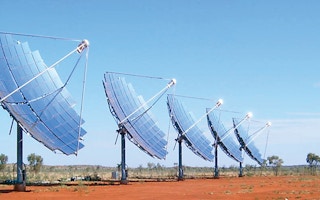The first stage of a huge solar farm in Victoria’s north has been finished and is feeding electricity into the grid, ending years of troubled development.
An array of 40 dishes covered in mirrors has been installed on a sheep property 30 minutes from Mildura. To generate power the dishes collect light and concentrate it towards solar converters at an intensity 500 times greater than normal sunlight. The project is now generating 1.5 megawatts of electricity, enough to power 500 homes.
The next step is to expand towards a 2000-dish farm generating 100 megawatts, enough for 30,000 homes. The project has already won $110 million in state and federal government grants towards building the full commercial project.
Silex Systems’ chief executive, Michael Goldsworthy, said the overall project would cost $250 million to $300 million, and the company still needed extra money before it went ahead. He said the company wanted to begin full-scale construction in late-2014, finishing in three years.
Launching the demonstration stage, Victoria’s Energy Minister, Nick Kotsiras, said renewables had to be part of the state’s energy mix, but power from brown coal would still have a future.
”Renewables are not the answer, they are part of the answer, an important part,” Mr Kotsiras said.
It has been a tough journey for the Mildura project. First launched in the mid-2000s, it almost fell over when the proponent company - Solar Systems - went into voluntary administration during the global financial crisis, costing 100 people their jobs.
It was later bought by Silex Systems. The whole project was originally due to be completed this year.
The head of the school of photovoltaic (PV) and renewable energy engineering at the University of New South Wales, Richard Corkish, said it was rare for concentration technology to be used with solar PV, as is the case at the Mildura farm.
Dr Corkish said the advantage of using concentration was that it improved the efficiency of the conversion of sunlight to energy.
But because concentrated technologies caught small areas of light, the arrays needed to be established in areas with low average cloud cover. They must also track the sun as it moved across the sky, a tricky and precise movement.










